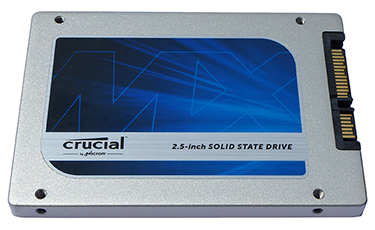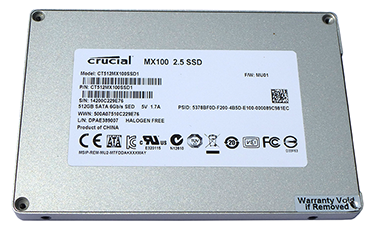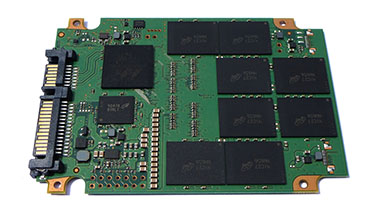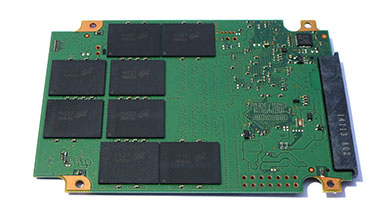A new breed of value drive
The transition to lower-priced SSDs occurs when the price of NAND drops through either supply inventory far exceeding demand or when manufacturers transition to smaller manufacturing processes.
Crucial is looking to control the controllables with the release of three MX100 value-focussed consumer SSDs. The first step in the quest for value is in using the smallest-possible geometry when fabricating the NAND chips, which make up the vast bulk of an SSD's cost. Smaller nm processes generally lead to more dies per wafer and consequently a lower cost per GB.
The MX100 takes this value thinking firmly onboard by equipping the 256GB and 512GB models with 16nm MLC NAND. The 128GB model, meanwhile, uses older 20nm NAND. The MX100 trio is considered replacements for the year-old M500 series - available in 120GB, 240GB, 480GB and 960GB capacities - with the also-available M550 occupying a higher performance echelon.
Here's how the trio of MX100 SSDs compare against one another and to the 480GB version of the M500.
Crucial SSDs |
||||
|---|---|---|---|---|
Crucial MX100 SSD Series |
Crucial M500 SSD Series |
|||
| Model | 128GB |
256GB |
512GB |
480GB |
| Controller | Marvell 88SS9189 |
|||
| NAND | 20nm Micron MLC NAND |
16nm Micron MLC NAND |
20nm Micron MLC NAND |
|
| NAND Packages | 8 |
16 |
16 |
16 |
| Die per NAND Package | 1 |
1 |
2 |
2 |
| Total Number of Die | 8 |
16 |
32 |
32 |
| Total Drive Capacity | 128GB |
256GB |
512GB |
512GB |
| Onboard DDR3 Cache | 256MB |
256MB |
512MB |
512MB |
| Interface | SATA 6Gb/s, compatible with SATA 3Gb/s and 1.5Gb/s |
|||
| Sequential Read Speed | up to 500 MB/s |
up to 500 MB/s |
up to 500 MB/s |
up to 500 MB/s |
| Sequential Write Speed | up to 150 MB/s |
up to 330 MB/s |
up to 500 MB/s |
up to 400 MB/s |
| Random IOPs (4KB Reads) | up to 80,000 IOPs |
up to 85,000 IOPs |
up to 90,000 IOPs |
up to 80,000 IOPs |
| Random IOPs (4KB Writes) | up to 40,000 IOPs |
up to 70,000 IOPs |
up to 85,000 IOPs |
up to 80,000 IOPs |
| Available Form Factors | 2.5in |
2.5in |
2.5in |
2.5in / mSATA /M.2 |
| Active Power Consumption | 150mW Typical |
|||
| Idle Power Consumption | <100mW Typical |
|||
| Life Expectancy | 1.2 million hours Mean Time Between Failures (MTBF) |
|||
| Endurance | 72TB total bytes written (TBW), equal to 40GB per day for 5 years |
|||
| Warranty | 3 Years |
|||
| Current Retail Price | £56 |
£82 |
£160 |
£180 |
Smaller NAND, better performance
Crucial uses 128Gb (16GB) dies for the MX100 series. The 128GB and 256GB SSDs have eight and 16 dies, respectively, one per physical NAND package, and the comparative lack of parallelism is evident in their mediocre sequential and random write speeds. Modern SSD controllers need access to 32 dies for better parallelism, as found on the 512GB model, so it's the one to go for if performance really matters.
For now, Crucial is content in retailing the MX100 with a standard 2.5in (7mm-high) SATA form factor alone. The older M500 is also available in M.2 and mSATA, perhaps explaining why it continues to exist in the presence of newer, better and cheaper technology.
We find it heartening that each MX100 is backed with the 72TB TBW endurance rating as the M500, equating to writing 40GB per day for five years. The rating is impressive insofar as smaller-geometry NAND, 16nm in the case of the 256GB and 512GB SSDs, is inherently less resilient to long-term writes.
This is because smaller cell structures are weaker - a fact exposed by long-term writing to cells - and can be subject to increased interference due to being located closer to one another. There's also no NAND overprovisioning on the MX100, historically useful for mitigating endurance-related concerns. Going by the specifications, Crucial appears to have found a workaround to this endurance/smaller-geometry problem.
Crucial's parent company is the NAND-producing Micron. Having such close ties to the manufacturer enables prices to be kept low, evidenced by the ultra-competitive entry point of £56 for the 128GB drive. The 256GB model, meanwhile, is priced at £82 and the largest-capacity drive at just £160. This is Crucial very much laying down the value gauntlet to competitors.
The drive
Presented in the usual aluminium casing and standing 7mm high, it's a shame that Crucial hasn't thus far released it in other form factors. SATA 6Gbps means a 550MB/s cap on real-world transfer speeds. The review model, 512GB in size, has the most parallelism of the trio and therefore offers the highest write speed.
Crucial provides a 7mm-9.5mm adapter for fitting the drive into regular chassis. Adding value, the bundle also includes a copy of Acronis True Image Software. We've used it for a while in the labs, for making images of test systems, and it works well and is easy to use.
Stripping away the cover reveals the same Marvell 88SS9189 controller. Supported by a 512MB cache, the drive's 16 NAND chips hold two 128Gbit dies apiece. But there's more to this new drive than implementing 16nm NAND on a consumer drive. Crucial has taken the opportunity to strengthen the drive's security features. Now, MX100 has additional capacitors that keep in-use data safe if the power is lost, AES 256-bit hardware encryption, and built-in thermal monitoring which can dynamically adjust performance (and therefore heat output) should matters become too toasty.
There's also a feature called termed Redundant Array of Independent NAND (RAIN), commonly found on the enterprise versions of parent company Micron's drives, where a portion of the drive's capacity is set aside for parity purposes. The relationship between the data elements and parity element determines the stripe ratio, where, for example, seven data elements can to tied to one parity element (7:1). Should a fault occur, the parity element, stored in a separate user-inaccessible area of the drive, is examined and the algorithm kicks in to reconstruct the surviving data.
This RAIN technology works well in principle when the data/parity ratio is low, as is the case on enterprise drives. However, this is more of a checkbox tick for this MX100 drive as Crucial can only give over a tiny portion of NAND to it. You wouldn't want, or need, 20 per cent of capacity reserved for such purposes on a consumer drive.
Summary
The MX100 improves upon the M500 by using cheaper-to produce NAND and implementing more security-focussed technologies. There appears to be no degradation in endurance when switching over to the 16nm NAND, which is a definite plus point, so let's see how the numbers stack up.













